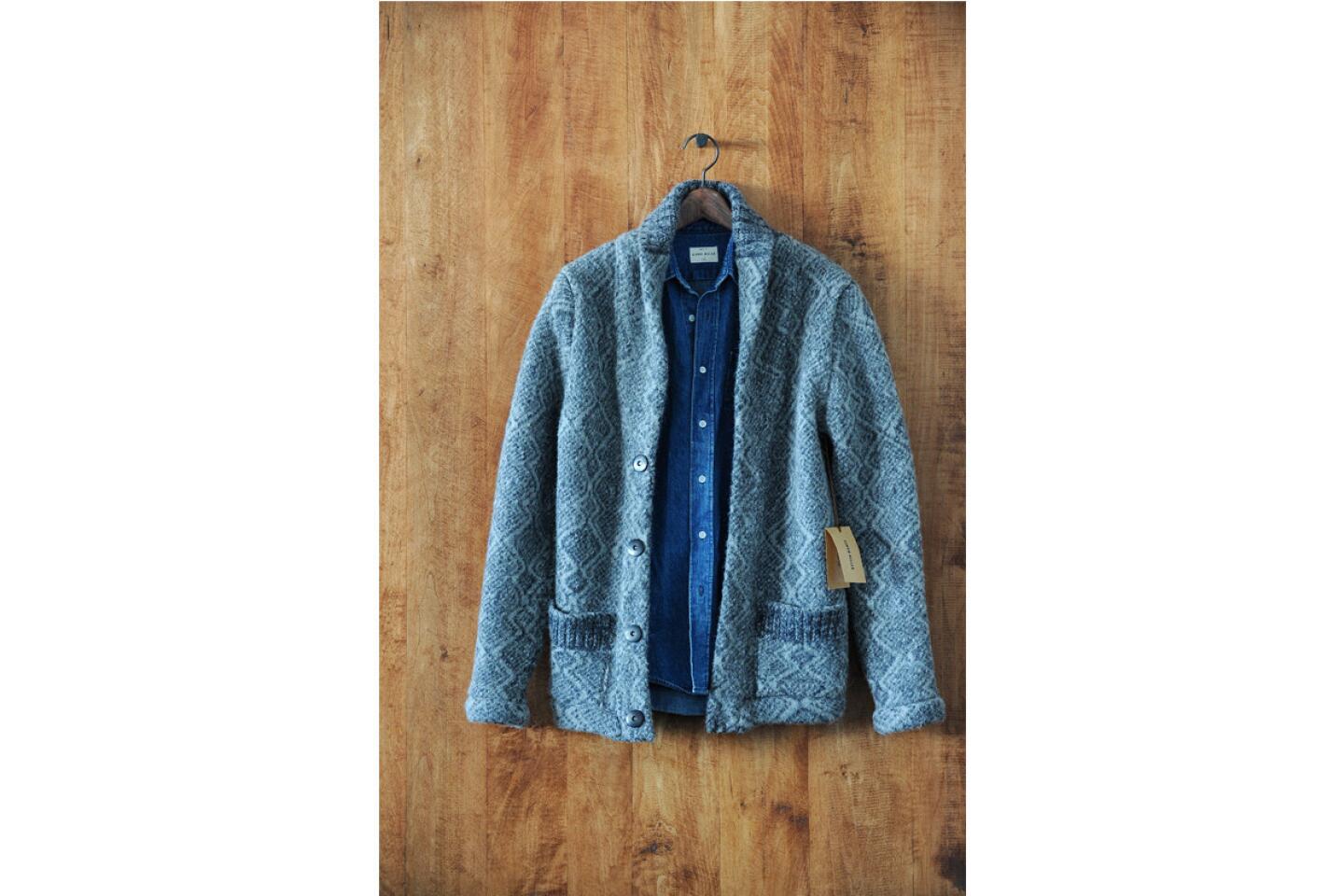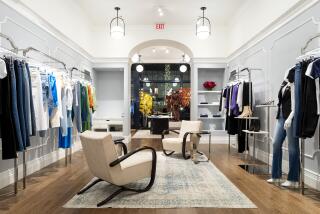Simon Miller, snug in denim, looks to fit into the wider fashion world
Los Angeles’ most important contribution to the modern wardrobe has been elevating the blue jean — the hard-wearing trouser of miners and cowboys — to luxury status, making denim a covetable commodity so meticulously and reverentially cut, sewn and hand-dyed that a single pair can easily cost a week’s take-home pay. But for a denim brand trying to transition from its five-pocket roots into a full ready-to-wear collection taken seriously by the fashion world, the L.A. rags-to-riches story arc is often as elusive as succeeding in Hollywood.
That’s why Daniel Corrigan and Jake Sargent, co-creative directors of Simon Miller, were determined from the outset to make sure their business had a bicoastal base, with a denim design studio in Los Angeles helmed by Corrigan and a sales office / showroom in New York City anchored by Sargent.
“The brand is ultimately rooted in the mood of the western U.S. — the pace of life, the midcentury architecture and vast landscapes — but we really felt like it was important not to be [pigeonholed as] a casualwear brand and not be a solely L.A.-based denim brand,” says Sargent. “We felt that put us into a box that wasn’t really how we wanted to grow things.”
It’s a strategy that appeared to pay off handsomely when, earlier this year, the duo was among the 10 finalists for the 2014 Council of Fashion Designers of America/Vogue Fashion Fund Award, which provides seed money, mentoring and visibility for emerging labels. The award, announced Nov. 3, went to shoe designer Paul Andrew, but not before the finalists got their share of the limelight.
“I don’t think we’d have the opportunity like the CFDA/Vogue Fashion Fund … if we hadn’t had the showroom in New York and some of the editorial exposure we’ve gotten as a result of that,” Sargent says.
Just as in Hollywood, being in the right place at the right time is important to landing a role, but it doesn’t trump talent and vision. Since taking the helm of the then-4-year-old brand from its namesake founder in 2011, Corrigan and Sargent have shown no shortage of either.
The pair have no formal fashion training: Corrigan, 29, studied graphic design and typography; Sargent, 27, studied business marketing. And they jumped in armed with little more than a pair of obsessions. For Corrigan, it was an infatuation with indigo; for Sargent, a fascination with the power of branding. They’ve grown what was a single fit of men’s denim in nine washes into a burgeoning empire that includes full men’s and women’s ready-to-wear collections, accessories and even furniture.
“To be completely honest, I didn’t come into fashion knowing about indigo,” Corrigan says. “But, when I started working with denim, I became obsessed — obsessed — with indigo. I learned the history of it, how to dye with it. I love, love, love everything about it. I turned a second bedroom in our house into a dye room, and I even started painting with it.”
That might sound like branding hyperbole. But there’s hardly a surface in the label’s downtown L.A. atelier that’s not swaddled, draped or splattered in a shade of blue. Besides the racks of jeans lining the walls and the huge table heaped with thick sweaters and loose-weave button-front shirts, there are bolts of indigo-dyed Japanese leather, an inky-blue canvas couch and a rectangular swatch of canvas daubed with thick swirls and smudges of dark blue that hangs on one wall (one of Corrigan’s indigo-based paintings). Even the company nameplate on the door outside refers to the hue, Indigoods LLC.
The brand has earned a reputation for detail-oriented washes. The men’s denim currently consists of narrow and slim fits available in 25 washes. The new women’s denim, which launched at Barneys New York for fall/winter, includes four fits in 11 washes. “And those are just the washes we decided to use,” Corrigan says, pointing to a rack of jeans that flanks nearly an entire wall.
“We probably have another 500 [washes] in boxes from the development process that we’ll go back to and look at for future seasons.”
That focus on washes — along with the use of only plant-based natural indigo and the nearly exclusive use of Japanese fabrics — makes for five-pocket jeans that range from $285 to $345. Another important part of that price? The line is produced entirely in Los Angeles.
That may sound expensive — especially in this post-denim-bubble era. But Sargent says the brand, which is carried at high-end retailers such as Barneys New York, Bergdorf Goodman, Ron Herman and Odin New York, has been experiencing “strong momentum.”
“We’ve been doubling sales season on season for three seasons in a row now,” he says.
“The Simon Miller jean appeals to a purist,” says Tom Kalenderian, general merchandise manager of men’s at Barneys New York. “The real denim dogs who still love original Levi’s and probably miss the original Helmut Lang jean collection.... The jeans are premium, but there are no bells and whistles. They’re all about the simplicity and straightforwardness and staying true to their concept. I think that’s the reason it is, and always has been, a very strong business for Barneys’ men’s store.”
The number of denim washes isn’t the only way the brand is growing. In recent seasons Simon Miller has added nubby sweaters, loose-weave button-front shirts, T-shirts and a parka-weight jacket. And in September, Corrigan and Sargent made their New York Fashion Week debut. The packed-house presentation unveiled a full spring/summer 2015 women’s collection that included tops, dresses and light outerwear. “It was a great launchpad to let the fashion world know we are doing women’s,” Corrigan says of the event.
“And we wouldn’t have done it if we hadn’t been nominated [as a CFDA/Vogue Fashion Fund finalist].”
The women’s collection includes shift dresses, button-front shirts and cropped tops in colors that range from white splattered with paint-like drops of indigo to dark and inky.
The dynamic duo of denim has also started to venture into the living room — first with a limited-edition Stephen Kenn furniture collaboration (oxidized copper couch frames, inspired by denim rivets, and indigo cotton canvas cushions lashed together with chunky leather belts) that hit retail in January, followed by a limited run of indigo, overdyed, geometric-patterned rugs.
Stand-alone retail is further in the future.
“What we really want to do is communicate the lifestyle of the brand,” Sargent says. “And one important way of doing that is through environment. What I’d like our next step to be is to take all these indigo pieces that we’ve got — the sofa, the rugs — and build out an environment that the customer can have access to.”
Kalenderian thinks Corrigan and Sargent are taking Simon Miller in the right direction and at the right pace. “The brand has legs,” he says. “And the customer is definitely hungry for more from them.”
He likens the label to other well-known brands that successfully grew far beyond their denim roots. “We’ve seen this with Acne, we’ve seen it with Rag & Bone. Those are two very meaningful, strong and dynamic examples of where this [growth] concept works very well.”
And thanks to the exposure of the CFDA/Vogue Fashion Fund program, the rise of the Simon Miller indigo empire isn’t coming completely out of the blue.
More to Read
Sign up for The Wild
We’ll help you find the best places to hike, bike and run, as well as the perfect silent spots for meditation and yoga.
You may occasionally receive promotional content from the Los Angeles Times.








